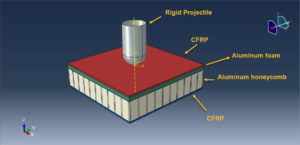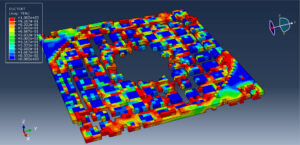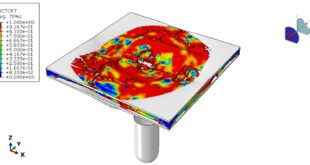In this tutorial, the Simulation of high-velocity impact on CFRP-Aluminum foam-Aluminum honeycomb-CFRP panel in Abaqus has been studied. The CFRP parts are modeled as three-dimensional parts with sixteen layers. The aluminum foam is modeled as a three-dimensional solid part. The aluminum honeycomb is modeled as a shell part. You can see a figure of the assembled parts below

Fiber-reinforced composite sandwich structures have been increasingly used in many advanced engineering applications, from aircraft bodies, sports cars, ships, bridge decks, and piers, to beams and columns of buildings, due to their high specific strength, high stiffness, lightweight, and corrosion resistance. However, accumulated evidence shows their vulnerability when impacted by heavy objects, bird strikes, tool drops, and loadings due to collision incidents. Impact loads cause severe damage to sandwich structures internally and externally in terms of substantial reduction in the tensile, compressive, shear, and bending strength since the event is instantaneous and the corresponding load magnitude can be many times that of its static
equivalent. Therefore, new strategies and designs to improve the impact resistance of such structures have been continually proposed and refined, rendering them an active research topic
The Crushable foam and damage criterion are considered to model metal foam like aluminum foam. The Johnson-Cook hardening and dynamic failure are used to model honeycomb behavior under severe load. The elastic and damage models are selected to define CFRP composite behavior
The dynamic explicit procedures, proper interactions, and constraints are applied. The fixed boundary condition is assigned to the bottom, and the initial velocity to the projectile. The proper meshes are assigned to all parts
After the simulation, all results such as stress, strain, fiber damage, foam failure, projectile penetration depth, and others are available. You can see some figures of the results below








 Abaqus tutorials Abaqus tutorials
Abaqus tutorials Abaqus tutorials




